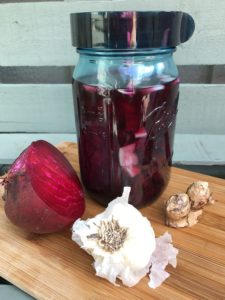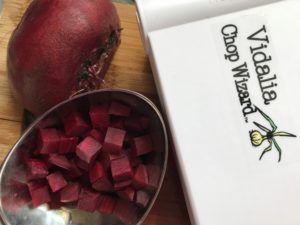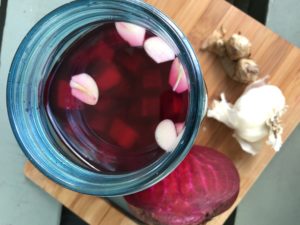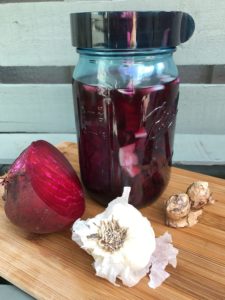So what in the world is beet kvass? The word kvass – originates from a Russian word “квасить [kvasit’]”, which means “to ferment”. So it is literally a fermented drink filled with loads of good bacteria called probiotics, numerous digestive enzymes derived from these bacteria, as well as short chain fatty acids, vitamins and many other beneficial compounds.  So any fermented drink really can be called kvass, like kombucha, for example. One of the most popular types of kvass is made from rye bread. Beet (Beta vulgaris rubra) kvass is basically the brine or liquid part of fermented beets. It used to be very popular back in the days. Unfortunately, it hasn’t been as widely used anymore.
So any fermented drink really can be called kvass, like kombucha, for example. One of the most popular types of kvass is made from rye bread. Beet (Beta vulgaris rubra) kvass is basically the brine or liquid part of fermented beets. It used to be very popular back in the days. Unfortunately, it hasn’t been as widely used anymore.
Due to numerous probiotic bacteria and many other factors this fermented drink has many wonderful health benefits. The taste is quite unusual but I personally liked it especially after I learned how many benefits it provides. It’s pretty easy to make, you don’t need to have any special skills.
It’s a great alternative probiotics containing fermented beverage which according to the latest report in Nature (the top scientific peer-reviewed journal) may contribute to improving your cardiovascular health and help you lose wight through altering intestinal microbiota. High concentrations of polyphenols, oligosaccharides, fiber (if you blend the actual beets in the kvass too) and nitrate (which is mostly present in beets) found in beets increase levels of nitric oxide in plasma and urine. Nitric oxide in its turn plays a major role in cardiovascular disease and as a result can help reduce the risk of developing cardiovascular diseases (like stroke and hypertension). This latest research in Nature also showed that beets containing juices can improve the diversity of your microbiome by lowering amounts of Firmicutes (associated with weight gain) and Proteobacteria and increasing levels of Bacteroidetes and Cyanobacteria. This change may contribute to weight loss and improve overall gut health.
So to summarise here are some of the most important benefits of beet kvass:
- High levels of nitrate, which turns into nitric oxide, helps to keep cardiovascular health, immune system and metabolism in homeostasis.
- Polyphenols – betalains, the molecules [also called phytochemicals] that give beets its very rich red color, have been shown in the lab to have anti-inflammatory, anti-oxidantant and chemo-preventative properties.
- Several different probiotic bacteria that can improve your microbiota, help digestion, improve your immune system and perform many other functions attributed to probiotics.
- Microbial digestive enzymes can help digest foods
- Vitamin C and other vitamins like Vitamin B and K produced by bacteria play very important role in your metabolism
- Rich in iron, boron and folate
- Neurotransmitters and other useful molecules produced by fermented bacteria
- Oligosaccharides are great food for selective good intestinal bacteria such as Lactobacilli and Bifidobacteria
- Rich in fiber beets improve digestion, metabolism and promote growth of healthy microbiota. To get more fiber in your kvass I recommend to partially blend raw beets in the blender and drink kvass in the form of smoothie
- May help loose weight
I hope now you are convinced to that beet kvass is a super food (or beverage to be exact).
Here is what you need for it and how to make it.
Equipment:
- Wide Mount Quart-Size (1L) Glass Jar
- Wide Mount Fermentation Weights
- Easy Fermenter Wide Mount Lid
- Vegetable Chopper
- Cutting Board
- Stirring Utensil (Plastic or Wooden [I prefer a good quality plastic to avoid cross contamination])
- Fine Nylon Mesh Strainer
- Quart Measuring cup
- Glass bottle for bottling (I am recycling 16-18 oz kombucha bottles with plastic cap purchased at the grocery stores)
- Norwex Envirocloth to clean the surface
- Stainless Steel Straws to enjoy chilled kvass
Ingredients:
- 1 Big Beet or 2-3 Small Beets
- 1 Ginger
- 2 Cloves of Garlic
- Himalayan salt
- Filtered water
Beet Kvass Preparation Method
- Clean the surface first to make sure your kvass don’t get contaminated by the bacteria from the environment. Advice from a microbiologist 🙂 I don’t like using toxic chemicals therefore I clean my surfaces with Norwex Envirocloth and water.
- Wash beets thoroughly. I love using my Norwex veggie and fruit scrub cloth for that. You can peel your beets or you can leave them with the skin on. It is optional.
- Cut the beets into small cubes. I love using my vidalia chopper for that. To get more fiber in your kvass you can blend 1/3 or 1/2 of your beets in a blender. This will make the fermentation process faster because all these carbohydrates will be more accessible for fermentation. And blending will increase the amounts of fiber and oligosaccharides in kvass that will feed your good bacteria in the gut.

- Add some cut ginger and garlic if you would like to flavour your kvass and add even more benefits to it.
- Add one teaspoon of salt. My total volume this time was 700 mls and one teaspoon of salt was just right.
- Add enough filtered water to cover the beats. You can also use glass weights to help beets to be contained in the jar.
- Cover the jar loosely with a plastic lid. I love using easy fermenter lids for all my ferments like sauerkraut. If you are new to fermentation or just want to have it easy then these lids might be for you too.
- Leave your beet kvass to ferment for about 5-7 days in a dark and warm place.
- Start tasting it on a day 3 and keep tasting it everyday until it gets to the right flavor you like.
- Strain, bottle and store it in refrigerator for up to a week.
- Enjoy sipping it via straw!

Recipes
Recipes about how to make kombucha, milk kefir and sauerkraut can be found here blog.


does fermenting beets, increase the amount and the bioavailability of betalains?
I’d heard of probiotics, but I didn’t know they were beneficial or that fermented beet juice could contain them. Personally, I’ve been having some different stomach troubles for the last few months and I’m looking for healthier things to eat and drink. I’ll have to look at getting some fermented beet juice.
Let me know how you like the beet kvass!
If it is fermented shouldn’t it keep in the refrigerator for a while?
yes, you can keep it in the refrigerator for about week or two.
How much of beet Kvas would you recommend to drink per day or per week for the best health benefits? Thank you!
You do not need to consume large amounts of fermented foods. 1 shot (like a vodka shot) a day would be a perfect amount to start with.